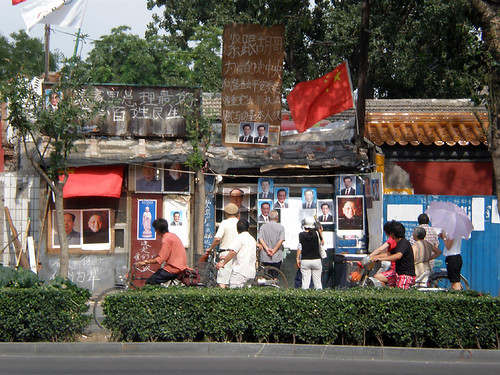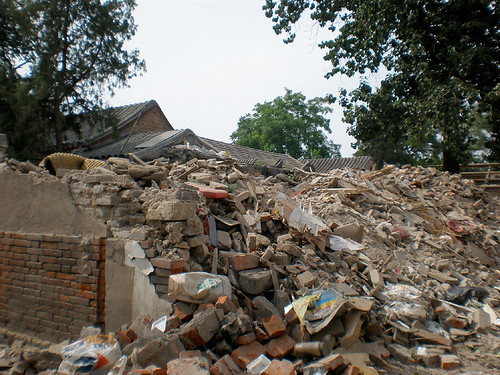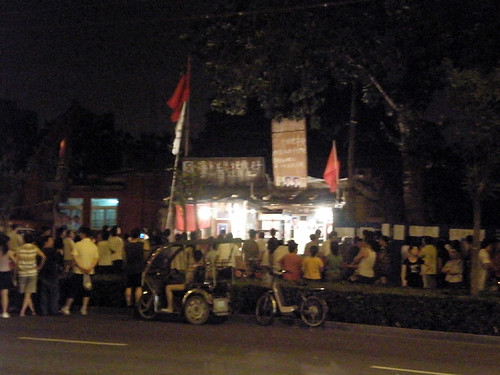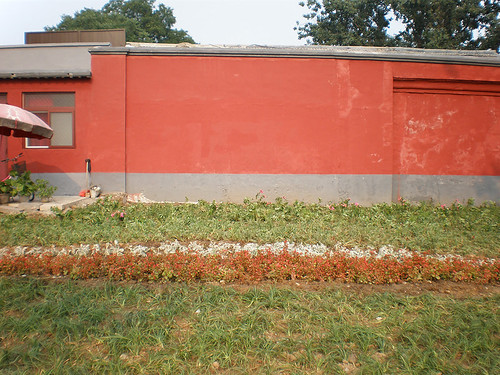
Spacing correspondent Megan Hall is in Beijing this summer. Over the next few weeks, she will be sharing her observations of China’s capital as it prepares to welcome the world to the 2008 Olympics.
– – – – – – – – – – – – – – – – – – – – – – – – – – – –
BEIJING — Just a few weeks ago, I was biking down one of Beijing’s main arteries in the middle of the day, when I saw a house that looked oddly out of place on the well-groomed throughway. What drew my attention were the posters of prominent Chinese Communist party officials throughout the years- Mao Zedong, Deng Xiaoping, Wen Jiabao, Hu Jintao. Three flags flew from the roofs of the shack — a People’s Republic of China flag, a Soviet Union flag, and an Olympic flag. Whoever put this together, was clearly trying to make a statement. There was a small crowd gathered out front, reading photocopies of officials documents glued to the building. Thanks to most of the reading I’ve been doing throughout my visit here, I was able to peg it as what the Chinese call a Nail House — a house that refuses to make way for new development and is therefore hard to hammer down. I had read a lot about these houses, but I had never seen one in person, and here one was, just minutes away from the Forbidden City and on a route that leads tourists directly up the Central Axis.
I had previously seen pictures of the famous Nail House in Chongqing, but what made this particular Nail House different was that the first stage of development had already taken place. Surrounding this house was a perfectly manicured park and a large red wall built on either side. Clearly, several houses had been torn down in order to make room for this development, and seeing as the space that the Nail House occupied was the only part of the wall not completed, this was clearly the issue that had led to the protest I was now witnessing.
These tall red walls are visible everywhere in Beijing and their main purpose appears to be to hide the old city. In every one of these walls there is an entrance to the old hutongs that, on most occasions, still lies within. What one finds upon entering is an entirely different world than the well-manicured and pristine streets that have been propped up for tourism’s sake. Half-destroyed houses and huge piles of rubble are scattered throughout these neighbourhoods and lay right next to occupied houses. On many occasions, people still live in buildings that are missing walls and ceilings.

The defining feature of each of these half-demolished neighbourhoods is the character “chaiâ€, meaning “to tear down.” These symbols are painted on in white paint, which shows up perfectly against the ubiquitous grayish-blue of the hutongs. Sometimes entire neighbourhoods will bear the character, a haunting symbol of the destruction that is soon to come. These neighbourhoods are not few and far between, either. I’ve biked through neighbourhoods that lay just on the other side of the street from Tiananmen Square (hidden behind a wall, of course), to hutongs like the one just off the Dragon Vein.

My curiosity kept me returning for many nights in a row to the Nail House, if for nothing else than to watch the community’s response to the excitement. More and more people showed up with every passing night, sometimes by the hundreds to sit, talk and wait. Police cars buzzed around the scene, never staying too long in front of the house. Some police vans sat empty in front of the house while plain clothed men got in an out every few minutes.
One night, the owner of the house emerged to thank everyone for their support. Only three days later at around eight in the evening, I passed by only to notice that the house was no longer standing. The house had been pushed in pieces onto the sidewalk so as to allow for gardeners to plant flowers and sod just as quickly as workmen could clear the debris. Yet another crew constructed a walking path out from the completed wall, which had already been finished and painted the same colour red as the wall surrounding it by the time I arrived. In just a few more hours, it would look as if the house had never existed at all.

This is the decaying past of Beijing that is so often talked about in modern history books and news stories. Although numbers vary, it is estimated that only a third of the hutong streets that composed Beijing 60 years ago are still standing. In their place grow office towers and malls, apartment buildings and new neighbourhoods of courtyard houses that are built to look old. The hutong streets that are unique to Beijing are quickly disappearing, and Nail Houses like this one are the final attempts by community residents to save their homes before they are destroyed by developers.
photos by Megan Hall

2 comments
Wow. Thanks Megan. Do you have pictures of the hutongs inside the red walls? I’m curious what that looks like, and what life looks like inside the walls compared to what’s going on outside of it.
And it looks like there is housing built into the wall to the left of where the Nail House stood. What’s that about? And what’s become of the Nail House occupants? Are they housed elsewhere (in prison??) or left homeless?
I surprised we haven’t had the knee-jerk, ‘don’t-criticise-China-you-insensitive-westerner-who-doesn’t-
understand-China’s-variety-of-human-rights’ comment yet.